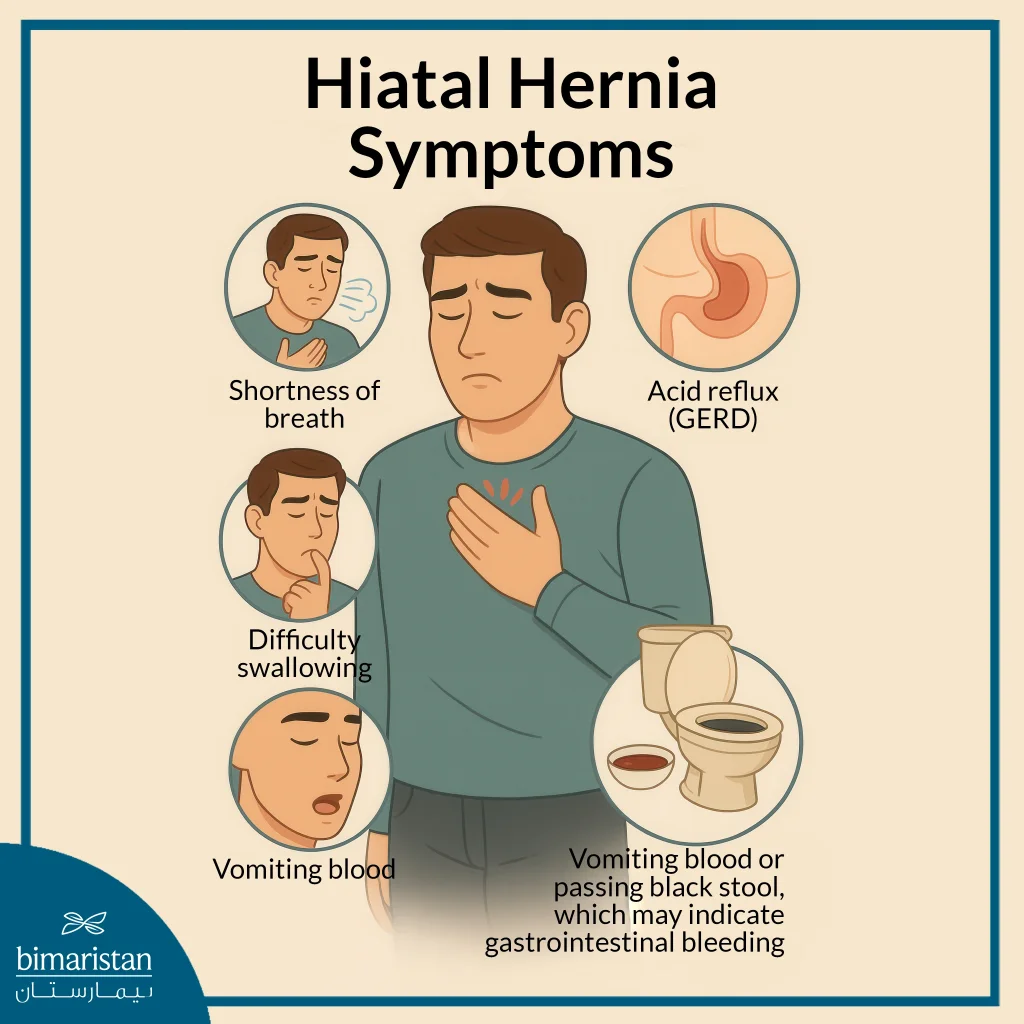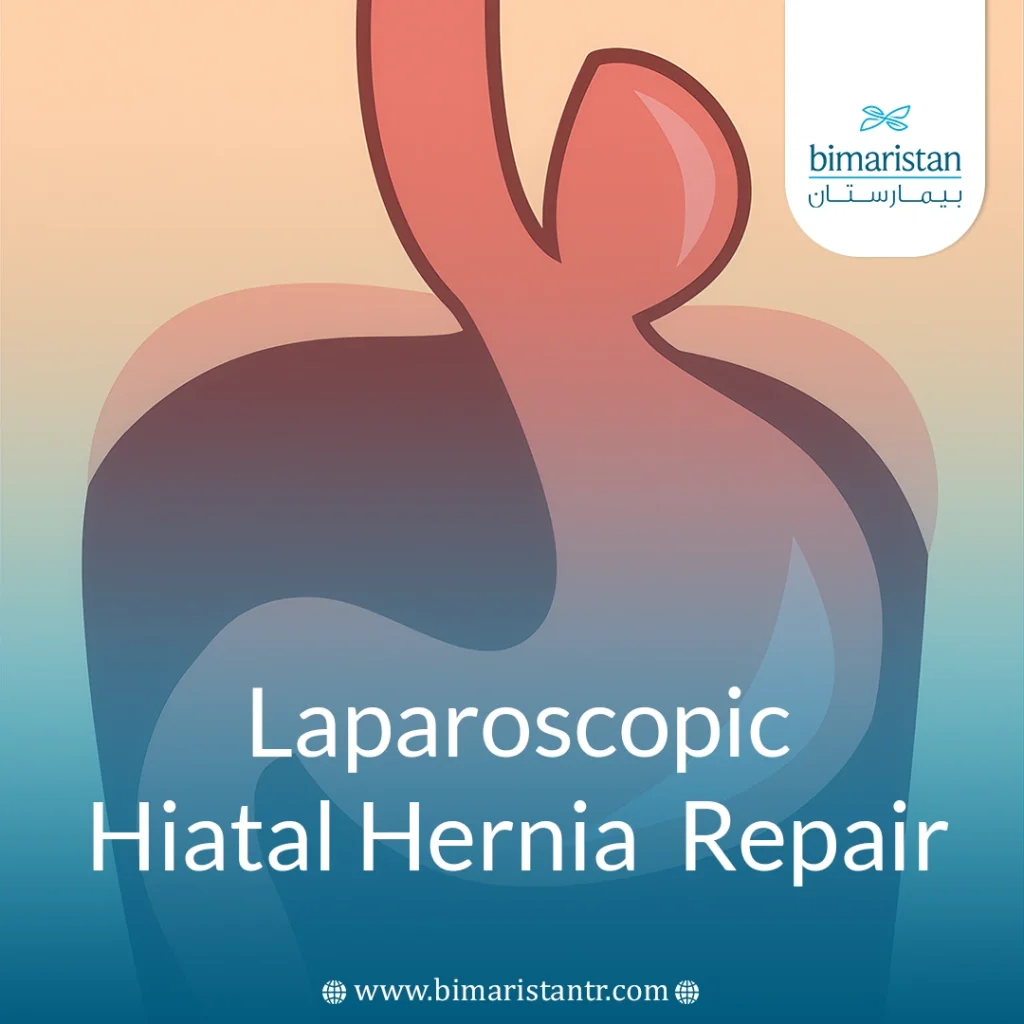Laparoscopic hiatal hernia repair has become one of the leading solutions for treating hiatal hernias, a condition in which part of the stomach protrudes into the chest cavity through the diaphragm’s opening. This can cause bothersome symptoms such as heartburn. With the advancement of medical technologies, laparoscopic hiatal hernia repair stands out as a modern approach, offering high precision, minimal pain, and faster recovery compared to conventional surgery.
Types of hiatal hernia
- Hiatal Hernia (Sliding Hernia): The most common type, occurring when the upper part of the stomach pushes into the chest cavity through the natural opening in the diaphragm.
- Congenital Diaphragmatic Hernia: Present from birth due to abnormal diaphragm development, allowing abdominal organs to move into the chest. It’s often diagnosed in newborns.
- Paraesophageal Hernia: A less frequent type where the junction of the esophagus and stomach remains in place, but part of the stomach slips alongside the esophagus into the chest, potentially leading to serious complications.
Symptoms of hiatal hernia
Small hiatal hernias may not produce noticeable symptoms, but larger ones can cause:
- Shortness of breath and difficulty swallowing
- Heartburn
- Gastroesophageal reflux disease (GERD)
- Chest or abdominal pain
- Early satiety (feeling full quickly after eating)
- Vomiting blood or passing black stool, which may indicate gastrointestinal bleeding

What is laparoscopic hiatal hernia repair?
Laparoscopic hiatal hernia repair is an advanced surgical technique in which the hernia is corrected using delicate instruments and a small camera inserted through tiny incisions in the abdomen. This approach reduces pain and recovery time compared to open surgery. It is considered a practical option for treating moderate to severe cases of hiatal hernia, especially when symptoms do not respond to medication.
When is laparoscopic hiatal hernia repair necessary?
- Failure of medical treatment (such as acid-reducing medications)
- Persistent symptoms like gastroesophageal reflux or difficulty swallowing
- Complications such as aspiration pneumonia or stomach obstruction
- Presence of a large hernia, even without noticeable symptoms
- Emergency cases such as gastric volvulus (twisting of the stomach)
Benefits of laparoscopic hiatal hernia repair
Laparoscopic hiatal hernia repair offers several advantages:
- Reduced postoperative pain, minimizing the need for strong painkillers
- Small scars and better cosmetic outcomes compared to conventional surgery
- Fast recovery with short hospital stays, typically between 36 to 48 hours
- High success rates that ensure stable and effective results
- Fewer complications compared to open procedures, increasing overall safety
These benefits make laparoscopic surgery the preferred option for many patients with hiatal hernia.
Steps of laparoscopic hiatal hernia repair
Laparoscopic surgery is a widely adopted and effective method for hiatal hernia treatment. The procedure includes:
- General anesthesia to keep the patient comfortable and pain-free during surgery
- Insertion of laparoscopic tools through 4–5 small abdominal incisions
- Separation of the esophagus from surrounding tissues
- Pulling the esophagus down into the abdomen
- Suturing the diaphragm opening to narrow it
- Performing stomach wrapping (Fundoplication), such as Nissen or Toupet technique
- Closing the incisions
What is the difference between conventional and laparoscopic surgery?
Conventional hiatal hernia surgery involves a large incision in the abdomen or chest, resulting in a longer recovery time. In contrast, laparoscopic hiatal hernia repair is less invasive, more precise, and safer for the patient.
Is laparoscopic hiatal hernia repair suitable for All Patients?
Although laparoscopic hiatal hernia repair is the first-line choice for many patients, it may not be suitable in all cases. It is not recommended for:
- Patients with large or complex hernias that are difficult to repair laparoscopically
- Those with extensive abdominal adhesions from previous surgeries
- Individuals with severe obesity or existing lung or heart conditions that prevent the use of carbon dioxide gas (used to expand the abdomen during laparoscopy)
Possible complications of laparoscopic hiatal hernia repair
- Difficulty swallowing
- Bloating or excessive gas
- Hernia recurrence
- Injury to nerves or blood vessels
- Need for revision surgery
Postoperative Tips for a Faster Recovery
To ensure optimal results after laparoscopic hiatal hernia repair, consider the following recommendations:
- Dietary care: For the first few days, stick to soft or liquid foods. Avoid spicy, fatty meals and large meals. Instead, eat small, frequent meals to minimize pressure on the diaphragm.
- Physical activity: Light walking is encouraged the day after surgery to prevent blood clots. Avoid heavy lifting or sudden bending for 4-6 weeks.
- Medical follow-up: Attend scheduled follow-ups to monitor wound healing and check for any abnormal symptoms.
Thanks to advancements in medical technology, laparoscopic hiatal hernia repair has emerged as a leading treatment option. It improves surgical outcomes and reduces complication risks. However, early diagnosis and proper follow-up play a critical role in long-term success. If you experience symptoms of hiatal hernia, don’t hesitate to consult the Bimaristan Medical Center for expert care.
Sources:
- Guideline Central. (2025, June 16). Latest hernia guidelines (SAGES, ASMBS, & more) – Guidelines rundown. Guideline Central InSights Hub
- Choi, S., Kim, T., Lee, Y., & Park, J. (2019). Long‑term outcomes and patient satisfaction after laparoscopic non‑absorbable mesh repair of hiatal hernia: a retrospective study. Journal of Minimally Invasive Surgery, 12(3), 145‑152

